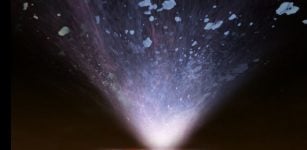Two Black Hole Merging Results In A Mass 142 Times Heavier Than Sun
Eddie Gonzales Jr. – MessageToEagle.com – Scientists from the University of Maryland, have detected two black holes merging, but one of the black holes was 1 1/2 times more massive than any ever observed in a black hole collision, according to research published in Physical Review Letters and Astrophysical Journal Letters.
This successful observation was possible thanks to a collaboration between The Laser Interferometer Gravitational-Wave Observatory (LIGO) and Virgo gravitational wave detectors.
 Numerical simulation of two black holes that spiral inwards and merge, emitting gravitational waves. The simulated gravitational wave signal is consistent with the observation made by the LIGO and Virgo gravitational wave detectors on May 21st, 2019 (GW190521). Credit: N. Fischer, H. Pfeiffer, A. Buonanno (Max Planck Institute for Gravitational Physics), Simulating eXtreme Spacetimes (SXS) Collaboration.
Numerical simulation of two black holes that spiral inwards and merge, emitting gravitational waves. The simulated gravitational wave signal is consistent with the observation made by the LIGO and Virgo gravitational wave detectors on May 21st, 2019 (GW190521). Credit: N. Fischer, H. Pfeiffer, A. Buonanno (Max Planck Institute for Gravitational Physics), Simulating eXtreme Spacetimes (SXS) Collaboration.
The researchers believe the heavier black hole in the pair may be the result of a previous merger between two black holes. This type of hierarchical combining of black holes has been hypothesized in the past but the observed event, labeled GW190521, would be the first evidence for such activity.
The gravitational waves from GW190521 were detected on May 21, 2019, by the twin LIGO detectors located in Livingston, Louisiana, and Hanford, Washington, and the Virgo detector located near Pisa, Italy.
The larger black hole in the merging pair has a mass 85 times greater than the sun. One possible scenario suggested by the new papers is that the larger object may have been the result of a previous black hole merger rather than a single collapsing star. According to current understanding, stars that could give birth to black holes with masses between 65 and 135 times greater than the sun don’t collapse when they die.
“The mass of the larger black hole in the pair puts it into the range where it’s unexpected from regular astrophysics processes,” said Peter Shawhan, a professor of physics at UMD, an LSC principal investigator and the LSC observational science coordinator.
“It seems too massive to have been formed from a collapsed star, which is where black holes generally come from.”
“Right from the beginning, this signal, which is only a tenth of a second long, challenged us in identifying its origin,” said Alessandra Buonanno, a College Park professor at UMD and an LSC principal investigator who also has an appointment as Director at the Max Planck Institute for Gravitational Physics in Potsdam, Germany.
“But, despite its short duration, we were able to match the signal to one expected of black-hole mergers, as predicted by Einstein’s theory of general relativity, and we realized we had witnessed, for the first time, the birth of an intermediate-mass black hole from a black-hole parent that most probably was born from an earlier binary merger.”
GW190521 is one of three recent gravitational wave discoveries that challenge current understanding of black holes and allow scientists to test Einstein’s theory of general relativity in new ways. The other two events included the first observed merger of two black holes with distinctly unequal masses and a merger between a black hole and a mystery object, which may be the smallest black hole or the largest neutron star ever observed.
“All three events are novel with masses or mass ratios that we’ve never seen before,” said Shawhan.
“So not only are we learning more about black holes in general but because of these new properties, we are able to see effects of gravity around these compact bodies that we haven’t seen before. It gives us an opportunity to test the theory of general relativity in new ways.”
Original story via Physorg
Written by Eddie Gonzales Jr. – MessageToEagle.com Staff










